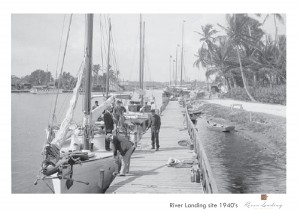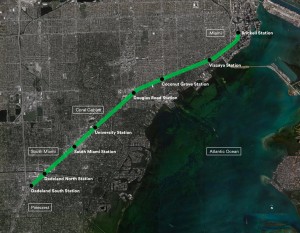Imagine a world where the bike path underneath the Metrorail tracks was a lush, safe, redeveloped linear park.
Where condo towers activated their waterfront spaces with restaurants, native plants, retail and outdoor activities.
Developers in Miami, which ranks 94th out of 100 cities for park acreage per 1,000 residents, are increasingly incorporating plans for linear parks in their projects.
Miami offers 2.8 acres per 1,000 residents, compared to 4.5 acres in New York and 6.2 in Los Angeles, according to the Trust for Public Land.
Local governments are now pushing developers to include park space in their plans.

The Miami River in the 1940s.
Developer Andy Hellinger is setting aside nearly 1 acre of waterfront space to create a linear park along the Miami River for River Landing, a $300 million development that will include 426,000-square-feet of retail, 475 apartments and more than 2,200 parking spaces.
The riverwalk at River Landing will be 850 feet in length and 50 feet in width, Hellinger told TRD.
“The way we designed our property, we wanted to invite people to enjoy the river,” he said. “We found some early drawings from the 1940s with people in the river. We wanted to bring that back to the urban community.”
Some portions along the 6-mile long river are not open, Hellinger said, but “all of the riverwalk is intended to be connected.”
River Landing’s waterfront park will be landscaped with native plants and materials and include access to development’s retail — a win-win for developers and residents.

Biscayne Line survey
The Related Group, along with ArquitectonicaGeo, has its own vision for the linear waterfront that runs parallel to Biscayne Bay: Biscayne Line.
Part of the Biscayne Line, Carlos Rosso, Related’s condo division president said, will link Edgewater’s bayfront, the Julia Tuttle Causeway and Museum Park in downtown Miami.
Related donated the park at Icon Bay, slated to open on June 26, to the city of Miami in April. The park, at 455 Northeast 28th Street, is designed by ArquitectonicaGEO, and will include water fountains, and exotic and native plants.
The goal, Rosso told TRD, is to activate green spaces with parks and restaurants, and “to create a fantastic public walkway for Miami.”
The developer unveiled plans for a Michael Schwartz-helmed restaurant at Paraiso Bay in Miami’s Edgewater neighborhood last month, also meant to activate the waterfront, he said.
Linear parks encourage connectivity, livability and walkability, according to Ken Krasnow, managing director for CBRE’s South Florida offices.
“There’s no easy way to quantify the impact of green space on an individual commercial property per se, but green space, including linear parks like the Highline in New York and the Underline soon to be developed in Miami, have an energizing effect — activating areas that were previously blighted or underutilized — which then draws investment to the area, and ultimately increased tax revenue,” Krasnow told TRD.

Map of the Metrorail path
The Underline, a proposed 10-mile long bikeway and linear park that runs underneath the Metrorail tracks in Miami-Dade, has the potential to encourage development and increase property values nearby.
“I spent most of my career in New York and witnessed firsthand the transformation,” Krasnow said, referring to the High Line’s effect on residential and commercial development.
The High Line, a 1.45-mile long elevated linear park in New York City, generated $3 billion in real estate development and an additional $1 billion in tax revenue, according to Krasnow. James Corner Field Operations, which led the design team for the High Line, was tapped earlier this year to design the Underline.
At meetings held by Friends of the Underline, the group behind the campaign to redevelop the M-Path into a linear park, city and county officials have reinforced the need for outdoor public spaces and supported the project.
“It would be impossible to put a number on it, but the hope is that the Underline will have a similar, positive impact on commercial real estate values in Miami,” he said.
Just last month, a 6,000-square-foot building near the proposed linear park sold for $4.25 million — three times the price the 19,000-square-foot lot last sold for in December 2012. Next to that is a planned 184-unit apartment complex, which is being developed by Grass River Property.
“There is a clear multiplier effect in terms of value — where people want to be living, working, playing [is] near these parks,” Krasnow said.
